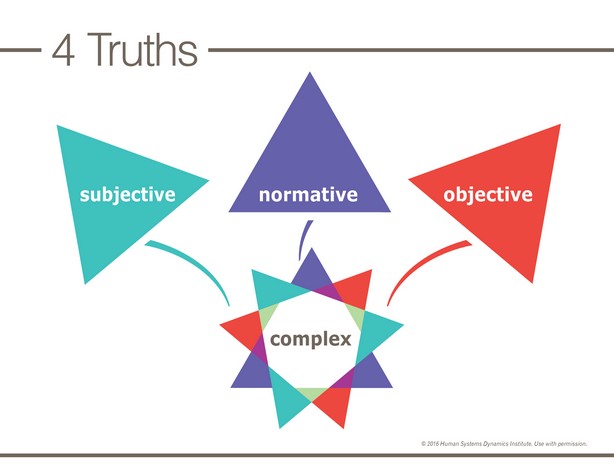Four Truths help you understand different perspectives that influence individual and group action. When you recognize and consider the possible perspectives in any situation, you are better able to navigate the differences that limit open dialogue and free action. The Four Truths, as a model and a method, provides you a way to consider multiple perspectives and then identify the one that is best fit to your purpose.

What?
In any situation, there can be as many descriptions of an event as there are people who experience it. The Four Truths, as a model, helps you understand such a phenomenon because it describes four ways people see their own truth in the world.
- Objective Truth is what exists and can be proved in this physicality. (The sun moves across the sky each day.)
- Normative Truth is what we, as a group, agree is true. (English speakers agreed to use the word day to name that time when the sky is lit by the sun.)
- Subjective Truth is how the individual sees or experiences the world. (Today is a good day for me.)
- Complex Truth recognizes the validity of all those truths and allows you to focus on the one is most useful at any given time. (The sun is up; the day is bright. Today is a good day for MOM, so lets take advantage of that and ask for ice cream for dinner.)
So What?
We use this model to help us understand different perspectives in our work with individuals, groups, teams, and organizations.
As a model, the Four Truths represents the various perspectives or ways we claim truth. As a method, it becomes the basis for inquiry and questioning as individuals and groups seek to:
- Identify their similarities and differences
- Find common ground for problem solving and decision making
- Understand others perspectives and actions
Now What?
Pay attention in times of disagreement or high emotion.
- Look for cues about how people see and share insights about what is happening.
- Share your observations to help others make sense of the situation.
- Use what you see together to identify and take your next wise action.
- Choose the kind of evidence that fits the needs
- Data for objective truth
- Stories for subjective truth
- Agreements and dialogue for normative truth
- Adaptive Action for complex truth
